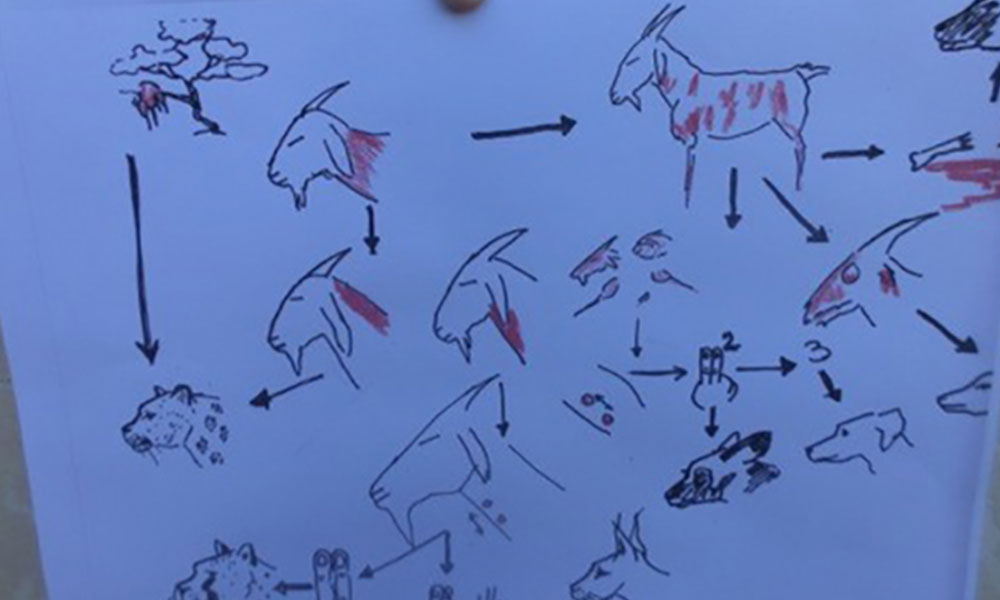E-Shepherd Collar Update – Kavango West
-

- by Gabriela Fleury June 1, 2018

The hardy acacias nearby Cheetah Conservation Fund gave way to a twisted masterwork of trees as Tyapa, CCF’s Smallstock Manager, and myself headed up towards Kavango West.
After a six-hour drive into a brand-new environment, it wasn’t difficult to notice differences as the region in the far North-East of the country is unlike anything I’ve seen so far in Namibia. Even something as ubiquitous as cattle is different – many of the cattle I’ve seen in Kavango West are sporting some truly impressive natural horns!
We arrived in the region on Monday the 14th of May to give a workshop on human-wildlife conflict mitigation practices and to introduce these farmers, who haven’t yet worked with us, to the CCF E-Shepherd project.
E-Shepherd collars go around the neck of a goat, sheep, or calf and when a predator chases the animals in a herd, this triggers the collar to emit a high-pitched sound alarm that is meant to deter the predator that is attacking. During our year-long study we are employing tests to gather data on collar usage. We are studying the effectiveness of collars to prevent livestock losses due to predation and the how collar usage effects farmer tolerance toward allowing predators on their land. To complete the study, every four months we will follow up with farmers who are participating in collar usage and neighbouring farmers who are not using collars. Farmers with or without collars is the only difference between both groups. All participants receive training and support toward predator friendly livestock farming. We have developed questionnaires that include a section to record livestock losses due to predation. It is the first time that CCF has done a workshop or deployed an extensive project in Kavango West and Tyapa and I were very excited to be part of this momentous event.
The workshop location was Pahukeni Guest House in Nkurenkuru town. Thirty-two individuals attended the workshop of which 3 (9%) were E-Shepherd recipients. Eleven (34%) individuals were female and twenty-one (66%) were males. The gender ratio is consistent in all areas where CCF works with the farming community. There tends to be more males than females actively farming and thus more males attend our workshops. Most of the attendees are leaders of their own farming unions or prominent members of their communities, and were passionate about disseminating information to their constituents.
The workshop began with the role of predators in the ecosystem and how to identify different predators by sight, track and kill styles. Using the dichotomous key handouts that I designed and a colleague drew, the workshop attendants broke into four groups and practised identifying tracks and kill styles of different predators (cheetah, jackal, domestic dog, and leopard). We received fantastic feedback from the farmers as to their enjoyment and the practicality and relevance of this exercise.


We also discussed CCF projects in the region (such as E-Shepherd) and how best to record instances of livestock losses and wildlife sightings. We then finished up with livestock husbandry and health information, and a lively discussion on different nonlethal ways to protect livestock from predators (e.g. livestock guarding dogs, strong kraals, herder training etc.)
Throughout the experience, the farmers were engaged, and had a great deal of questions concerning different nonlethal ways to protect livestock. We enjoyed working with them in return. As a cherry on the top of this visit one of our new E-Shepherd project farmers in Kavango West told us about a loss of sheep three months previous and prior to receiving a collar. After he completed the Kill ID activity with us, he was able to identify the predator (a leopard) from his memory of the incident. Not only is Kill ID a fun activity, it is essential for farmers to know the varying ways in which predators, attack and consume their prey. By understanding which predator is the main species involved in a farmer’s livestock losses, the farmers themselves are better positioned to protect their livestock by employing different nonlethal methods. It feels good to be disseminating practical information that farmers can use, not just now, but in the future!
After the workshop, we deployed seven smallstock E-Shepherd collars and seven calf collars with three farmers, bringing our total of deployed collars up to 87 (whew!) with 53 individual farmers in three different areas (Kavango West, Hereroland (in north-central Namibia near CCF) and next to the Waterberg National Park).
Most importantly, we were lucky enough that evening to discuss livestock management with one of our E-Shepherd farmers around the family fire, under the wash of the Milky Way. It was the warmest welcome I can ever remember receiving.

Related Reading
-
December 4, 2024
Double Your Donation for the Cheetah -
June 15, 2024
Snake Aversion Training




